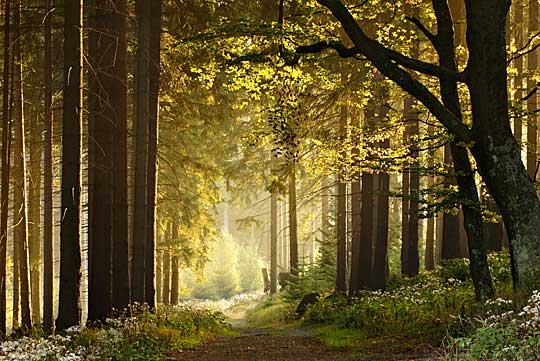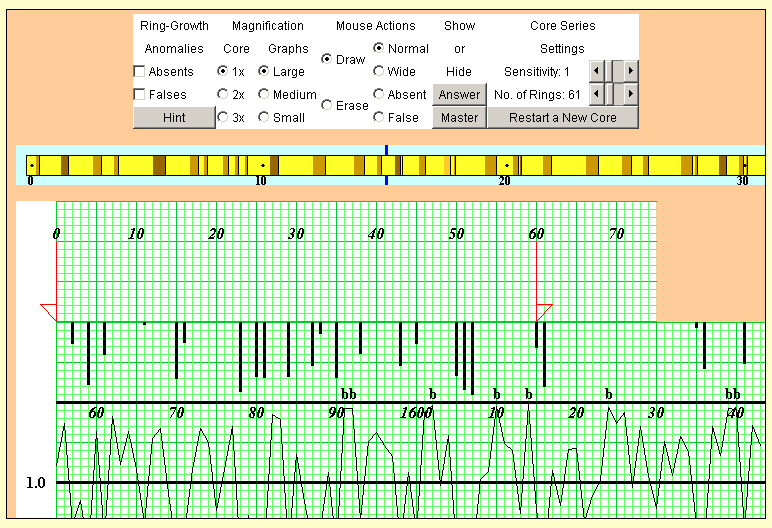Perspectives on Trees
A few weeks ago, my fall semester field biology students and I began our studies of forest ecology. Luckily before the majority of our local trees demonstrated their deciduous nature, we were able to travel into the field and collect quite a diversity of leaves for identificaiton. More recently, we have turned our attention to dendrochronology methods and using the point-quarter-method for determing tree density, dominance, and frequency.
Normally, I wouldn’t have considered sharing such information but during the past week, two NPR broadcasts have inspired me to do so. More specifically, the inspriation came from Robert Kruwich‘s “Krulwich on Science” radio segments. Links to the specific radio segment follow, with a few related class resources that I have used while teaching about dendrochronology and forest density.
Dendrochronolgy Broadcast & Resources
- Krulwich On Science – How A-Bomb Testing Changed our Trees
This 4 minute audio takes us back in time to the 1950’s and discusses how the radiation produced by our atmospheric testing of atomic bombs caused an increase in atmospheric C14 and, in turn, a spike in C14 found in plants of this age (chemical tree ring). - Brain McCarthy’s Introduction to Dendrochronology at Ohio University
I have used this site to introduce my students to the basic botany associated with the production of tree rings, as well as the field and lab methods associated with collecting and analyzing tree cores (at the moment his botany primer link is broken). - Paul Sheppard’s Crossdating Tree Rings using Skeleton Plotting at the Univ. of Arizona
I have also used this site to introduce my students to some of the basic botany associated with the production of tree rings. The highlight of this site is an interactive Java applet. In this activity you receive a virtual tree core (as seen below). Next, you follow the methods covered at the site to create a skeleton plot. Finally, you use a master reference chronology (at the bottom of the screen shot) to determine the dates associated with your tree core.
Forest Density Broadcast & Resources
- Krulwich On Science – Going Out on a Limb with a Tree-Person Ratio
In this 5 minute audio sement we learn about recent research by Nalini Nadkarni of The Evergreen State College to estimate the number of tree on Earth and her subsequent calculations to determine the number of trees per person. The segment further discusses our use of tree-based resources. - Using the Point Quarter Method –
An Activity for Estimating Tree Density, Dominance, & Frequency
Before taking my students outside to use the point-quarter method for determining tree density, dominance, and frequency, I usually have them do this simple paper activity that familiarized them with the protocol and the concepts of density, dominance, and frequency.
Robert Krulwich’s “Kulwich on Science” radio segments are multifaceted productions. They are short enough to use as a nice anticipatory set, educate about scientific research, integrate science and society, and are engaging and humorous to students and teachers alike.
So, whether or not you teach about trees and forest ecology, I would recommend that you listen in once in awhile.



Here’s a reference that helps to document Kansas Old Growth Cross Timbers—like the site at Toronto State Park.
The Ancient Cross Timbers Consortium
Great stuff Eric! McCarthy did a nice article going over the basics of how to do a dendrochronology-climate lab in American Biology Teacher back in ’02 or ’03, for anyone interested who has back issues or membership to browse on NABT’s site.
Also, tree ring junkies may really dig U Tenn prof Henri Grissino-Mayer’s terrific website whose name says it all: “The Ultimate Tree-Ring Web Pages.” Its target audience is professional dendros, but he’s got tons of terrific info on anything related to tree rings. His photo gallery has some amazing shots, from multiple fire scars on a ponderosa section to photomicrographs of bristlecone pine rings.
For anyone who read this far into the comment — you might be a fellow ring nut! If you can get to Olathe South, then I have a stack of wood specimens you can borrow from, short- or long-term, depending on how much I use it in teaching. In the stacks are core samples from western softwoods and eastern hardwoods, as well as “cookies” (cross-sections) of a variety of species. Quite a number are samples from western trees that go back 200-400 years.
Jeff Witters
Olathe South High School
Sorry.
When I wrote “such birds” I obviously wasn’t thinking clearly.
Knowing that I am not the greatest of birders, I asked my middle daughter (without promting) what I have been calling these birds, as we drove back by them the other day. She said “crows”. So it goes.
I will be more careful in the future.
Eric,
You’ve got a scoop if you’ve been seeing ravens on the plaza–certainly there are corvids down there but if you’ve been seeing ravens you’ll have every bird watcher in KC down there trying to see them….
I’m really partial to Ravens–always have been but Heinrich’s work just solidified it.
BW
I had to be “inspired” Brad.
I will try to get inspired more frequently.
Otherwise, thanks for the book suggestion. I have read a few of his other books, but not the one you suggested.
In fact, the most recent book I have partially read of his is the “Mind of the Raven”, and while picking up my daughter from school near the plaza the past week or two there has been quite a congregation of such birds along brush creek. I have been hoping that some idea would come to mind providing a means for my students to study this unique and intelligent resource. I haven’t thought of anything yet…
Nice post, Eric. Not sure why you wouldn’t normally post about such activities–I think you should.
Another resource that can serve as a model for how to ask some interesting “tree” research questions is Bernd Heinrich’s book: Trees in My Forest